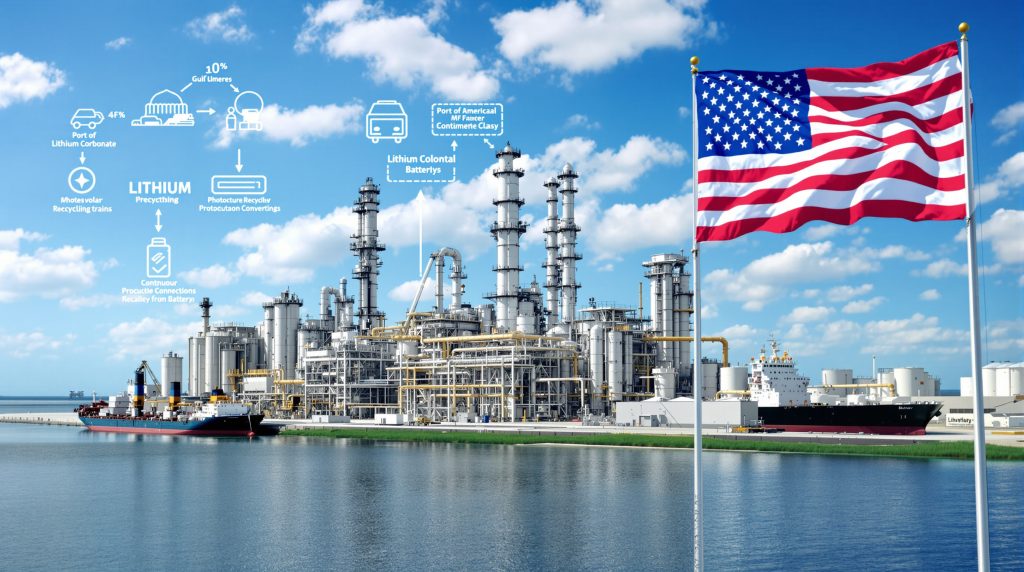Lithium Refining Revolution: How Texas Fits into Lithium Universe's Strategic Expansion
The global race to secure lithium supply chains is intensifying as battery manufacturers and automakers compete for reliable sources of this critical mineral. At the center of this competition is a critical challenge facing North America: the "lithium conversion gap." Lithium Universe's bold move to establish a second refinery in Texas represents a strategic response to this challenge, creating a dual-location processing platform spanning the United States and Canada.
What is the Lithium Conversion Gap and Why Does It Matter?
North America faces a significant disconnect between its battery manufacturing ambitions and its lithium refining capabilities. While billions of dollars are being invested in battery gigafactories across the continent, the region lacks sufficient domestic capacity to convert raw lithium materials into the high-purity compounds these facilities require.
This "lithium conversion gap" has created a precarious situation where battery manufacturers must rely heavily on overseas refineries, particularly in Asia. The dependency introduces multiple vulnerabilities:
- Supply chain risks: Reliance on long international shipping routes exposes manufacturers to logistical disruptions
- Geopolitical concerns: Critical minerals energy security becomes subject to international relations
- Economic leakage: Value-added processing occurs offshore rather than creating domestic jobs
- Sustainability impacts: Extended transportation increases carbon footprint of battery production
Without addressing this bottleneck, North America's transition to electric vehicles faces significant headwinds, potentially slowing adoption rates and limiting economic benefits. The gap between regional demand and processing capabilities continues to widen as more battery manufacturing capacity comes online.
Industry analysts project North American lithium demand could increase five-fold by 2030, while current domestic refining capacity meets less than 10% of anticipated needs. This disparity has prompted governments to implement policies specifically targeting this vulnerability in the battery supply chain.
Why is Lithium Universe Expanding to Texas?
Lithium Universe's announcement of a second lithium carbonate refinery in Brownsville, Texas represents a strategic expansion of the company's North American footprint. This development complements rather than competes with the company's flagship Bécancour project in Québec.
According to Iggy Tan, Executive Chairman of Lithium Universe Ltd, "Brownsville represents an extraordinary opportunity to extend our lithium refinery strategy beyond Québec. With the Inflation Reduction Act, Department of Energy programs, and clear national ambitions for critical mineral independence, the timing is ideal to establish a foothold in Texas."
The dual-location strategy creates a binational processing platform that addresses different regional markets while maximizing policy advantages in both countries:
Strategic Geographic Positioning
- Québec facility: Serves as a Trans-Atlantic hub powered by Hydro-Québec's renewable energy, primarily supplying Canadian and European markets
- Texas facility: Functions as the U.S. hub, integrated with Gulf Coast logistics and positioned closer to American gigafactories
This geographic diversification offers several compelling advantages:
- Risk mitigation: Reduces vulnerability to regional disruptions by operating in two distinct jurisdictions
- Market access: Places processing capacity closer to end-users, reducing logistics costs and complexity
- Policy optimization: Leverages incentives available in both U.S. and Canadian regulatory environments
- Feedstock flexibility: Enables sourcing of raw materials from diverse global suppliers
- Customer diversification: Facilitates relationships with battery manufacturers in multiple markets
Importantly, the company emphasizes that Bécancour remains its first priority, with the definitive feasibility study completed and offtake discussions underway. The Texas initiative represents a parallel growth pathway rather than a diversion of focus.
What Makes Brownsville an Ideal Location?
The Port of Brownsville Business Park offers a unique combination of logistical, infrastructural, and economic advantages that make it particularly well-suited for lithium refining operations:
Strategic Logistics Benefits
The site's multimodal connectivity creates exceptional efficiency for both incoming raw materials and outgoing refined products:
- Deep-water port access: Enables direct maritime transport of spodumene concentrate from global sources including U.S., Brazilian and African mines
- Highway connectivity: Adjacent to major transportation corridors for efficient distribution to U.S. battery manufacturers
- Rail infrastructure: Direct connections to national rail networks further diversify logistics options
- Proximity to technology corridor: Located approximately 230km south of Tesla's lithium hydroxide refinery at Corpus Christi and near SpaceX's Boca Chica Starbase facility
Infrastructure Readiness
The industrial-zoned location offers significant advantages for rapid implementation:
- Pre-existing utilities: Established power, water, and gas infrastructure reduces capital requirements
- Industrial ecosystem: Surrounding industrial operations create shared resources and services
- Flat terrain: Simplifies construction and reduces site preparation costs
- Brownfield benefits: Building within an established industrial zone streamlines permitting processes
Economic Advantages
The Texas location offers distinct cost benefits compared to alternative sites:
- Competitive labor market: Access to skilled chemical processing workforce at competitive rates
- Lower land costs: More affordable property values compared to other industrial centers
- Tax environment: Texas offers favorable tax treatment for manufacturing operations
- Business climate: Pro-industry regulatory approach reduces compliance complexity
- Expansion potential: Sufficient land for multiple processing trains and complementary operations
The site is reportedly large enough to accommodate both lithium refining and photovoltaic recycling operations, creating potential for a multi-commodity clean energy hub. This co-location strategy creates operational synergies while maximizing the economic value of the property.
How Will the Texas Refinery Be Designed?
Lithium Universe plans to implement a "copy-and-paste" approach for its Texas facility, replicating its proven Bécancour refinery design with strategic modifications for the Gulf Coast environment:
Technical Specifications
The refinery's core parameters demonstrate significant production capacity:
- Production capacity: Each refinery train designed to produce approximately 18,270 tonnes per annum (tpa) of battery-grade lithium refinery
- Scalable configuration: Facility designed for dual-train operation, potentially exceeding 36,000 tpa at full capacity
- Process technology: Utilizing the established Jiangsu continuous-process flow methodology
- Gulf Coast adaptations: Removing cold-weather modifications while adding hurricane-specific structural safeguards
- Integrated operations: Site large enough to accommodate both lithium refining and photovoltaic recycling operations
The continuous-flow process technology represents a mature, proven approach to lithium refining, contrasting with some experimental technologies being explored elsewhere in the sector. This established methodology reduces technical risk while maintaining high product quality.
Economic Outlook
Based on the Bécancour definitive feasibility study (DFS), the economic parameters for the Texas facility appear promising:
- Net present value: US$718 million (Bécancour reference)
- Internal rate of return: 21% (Bécancour reference)
- Payback period: Under four years (Bécancour reference)
- Potential enhancement: Lower construction and operating costs in Texas may improve these metrics further
The copy-and-paste approach offers significant economic advantages beyond the direct financial metrics:
- Reduced engineering time: Using existing designs minimizes front-end engineering costs
- Lower technical risk: Implementing proven systems rather than unproven technologies
- Accelerated timeline: Faster path from approval to production
- Supply chain efficiency: Established relationships with equipment suppliers
- Operational familiarity: Consistent processes enable shared expertise across facilities
This pragmatic approach prioritizes execution speed and reliability over experimental technologies that might offer theoretical advantages but with higher implementation risks.
How Does This Fit into U.S. Critical Minerals Strategy?
The Brownsville refinery aligns seamlessly with several key U.S. policy initiatives aimed at securing domestic supply chains for critical minerals:
Policy Alignment
The project intersects with multiple federal priorities:
- Inflation Reduction Act: Domestically refined lithium compounds qualify for significant tax credits under the IRA's domestic manufacturing provisions
- Critical Minerals Security: Supports U.S. goals of reducing dependency on foreign processing, particularly from geopolitical competitors
- Tariff Advantages: Avoids the 25% tariffs imposed on Chinese lithium compounds, creating a significant price advantage for domestic production
- Department of Energy Support: Potential eligibility for loan programs specifically targeting critical minerals infrastructure development
This policy environment creates substantial financial incentives for domestic lithium refining, effectively reducing capital costs and improving project economics compared to historical conditions.
Supply Chain Integration
The facility creates strategic connections across the battery value chain:
- Upstream integration: Direct access to spodumene concentrate from domestic and international sources
- Midstream processing: Converting raw materials into battery-grade compounds domestically
- Downstream proximity: Reducing logistics costs and complexity for U.S. battery manufacturers
- Circular economy potential: Co-location with recycling operations creates opportunities for materials recovery
By addressing the critical midstream processing bottleneck, the facility helps complete a domestic supply chain that has been fragmented and heavily dependent on overseas processing. This integration reduces transportation costs, carbon emissions, and supply chain risks while capturing more economic value within the North American economy.
Strategic Independence Benefits
Beyond direct economic advantages, the facility contributes to broader national objectives:
- Energy transition enablement: Supporting domestic electric vehicle manufacturing capacity
- National security enhancement: Reducing dependency on potentially unreliable international sources
- Innovation ecosystem development: Creating clusters of battery-related expertise and capabilities
- Export potential: Establishing capacity that could serve international markets in addition to domestic needs
These strategic benefits align with broader governmental objectives of ensuring critical mineral security while transitioning to lower-carbon energy systems.
What's the Timeline and Next Steps?
While Lithium Universe emphasizes that Bécancour remains its first priority, with the definitive feasibility study completed and offtake discussions underway, the company is advancing the Texas initiative along a parallel track:
Development Pathway
The Texas project is progressing through several concurrent workstreams:
- Site evaluation: Currently assessing specific land parcels within the Port of Brownsville Business Park
- Regulatory pathway: Engaging with relevant authorities to establish permitting requirements
- Engineering adaptation: Modifying the Bécancour design for Gulf Coast conditions
- Funding strategy: Exploring U.S. government support mechanisms and potential partners
This multi-track approach allows for efficient progression while maintaining flexibility to adjust based on findings from each workstream.
Key Milestones
While specific dates have not been disclosed, the logical sequence of milestones would include:
- Site selection finalization: Completing land acquisition within the industrial park
- Permitting applications: Submitting environmental, construction, and operational permits
- Engineering completion: Finalizing Gulf Coast-specific design adaptations
- Funding arrangements: Securing government support and private financing
- Construction commencement: Breaking ground once permits and financing are secured
- Commissioning and startup: Systematic activation of processing systems
- Commercial production: Achieving design capacity and quality specifications
Chemical processing facilities typically require 18-24 months for construction once permits are secured, suggesting a multi-year development timeline from announcement to production.
Parallel Process Considerations
The company's dual-project strategy creates both challenges and opportunities:
- Resource allocation: Balancing management attention and capital between projects
- Knowledge transfer: Applying lessons from Bécancour to optimize Texas implementation
- Staged development: Potential to sequence construction for capital efficiency
- Supplier relationships: Leveraging economies of scale across two similar facilities
The parallel development approach potentially creates synergies between the projects while diversifying execution risk across multiple jurisdictions.
How Does This Compare to Other North American Lithium Projects?
The Brownsville refinery represents a distinct approach compared to other North American lithium initiatives:
Competitive Positioning
Several factors differentiate Lithium Universe's approach from competitors:
- Focus on midstream processing: Unlike many competitors focused on mining or battery manufacturing, Lithium Universe targets the critical refining bottleneck
- Proven technology transfer: Leveraging established processing methods rather than experimental approaches
- Dual-location strategy: Creating geographic diversification that most single-site competitors lack
- Integrated recycling potential: Building synergies between primary refining and materials recovery
This specialized focus on the conversion gap contrasts with vertically integrated approaches that attempt to control the entire supply chain but may lack specific expertise in the complex chemistry of lithium refining.
Market Differentiation
The facility's design philosophy creates additional competitive advantages:
- Rapid deployment potential: Copy-and-paste design approach enables faster implementation than custom facilities
- Scalable capacity: Modular train design allows phased expansion to match market growth
- Multi-commodity potential: Facility designed to accommodate both lithium processing and recycling operations
- Trans-Atlantic platform: Combined with Bécancour, creates a unique dual-continent processing capability
This combination of speed, flexibility, and geographic diversification creates a more resilient business model compared to single-site operations with less adaptable designs.
Competitive Landscape
The North American lithium processing sector remains underdeveloped relative to demand, with limited existing capacity:
- Current operations: Albemarle's Silver Peak (Nevada) and Livent's operations remain the primary active lithium producers in the U.S.
- Announced projects: Tesla's Corpus Christi facility and Albemarle's Kings Mountain expansion represent major competing initiatives
- Market gap: Even with all announced projects, significant supply shortfalls are projected through 2030
The limited competitive landscape suggests sufficient market demand for multiple successful projects, especially those able to achieve production before 2027 when supply constraints are expected to be most acute.
What Are the Environmental Considerations?
The Brownsville facility incorporates several sustainability elements designed to minimize environmental impacts while maximizing resource efficiency:
Environmental Design Elements
Modern refining operations incorporate numerous sustainability features:
- Potential for renewable energy integration: Texas offers significant solar and wind resources that could power operations
- Water management innovations: Process designs that minimize freshwater consumption through recycling and treatment systems
- Circular economy synergies: Co-location with recycling operations reduces transportation impacts while enabling materials recovery
- Modern emissions controls: Implementation of latest technologies to minimize air quality impacts
These design elements reflect contemporary expectations for industrial facilities, particularly those in the clean energy supply chain.
Gulf Coast Adaptations
The Texas location presents specific environmental considerations:
- Hurricane resilience: Structural reinforcements and drainage systems to manage extreme weather events
- Heat management: Systems designed for high ambient temperatures and humidity
- Flood mitigation: Site elevation and drainage to manage coastal flood risks
- Habitat protection: Compliance with regulations protecting sensitive coastal ecosystems
These adaptations ensure environmental protection while maintaining operational reliability in the Gulf Coast environment.
Permitting Pathway
Chemical processing facilities require comprehensive environmental permits:
- Air quality permits: Emissions monitoring and control systems to meet Clean Air Act requirements
- Water discharge permits: Treatment systems to ensure any water releases meet quality standards
- Waste management planning: Systems for handling and disposing of processing residues
- Environmental impact assessment: Comprehensive evaluation of potential environmental effects
The established industrial zone location potentially streamlines this process compared to greenfield sites in less developed areas.
"Environmental performance of any chemical processing facility depends on both design specifications and operational practices," according to ListCorp's analysis of Lithium Universe's Texas plans. "Actual outcomes will depend on regulatory compliance, operational management, and ongoing monitoring and mitigation efforts."
FAQ: Lithium Universe's Texas Expansion
How does this project affect Lithium Universe's Québec priorities?
Bécancour remains the company's primary focus, with the Texas initiative representing a parallel growth pathway rather than a diversion of resources. The company emphasizes that its Québec project continues to advance with offtake discussions underway.
What advantages does Texas offer compared to Québec?
While Québec offers exceptional renewable energy resources through Hydro-Québec, Texas provides advantages in terms of logistics, permitting timelines, labor costs, and proximity to growing U.S. battery manufacturing centers. The two locations complement each other strategically.
How does the facility address the "lithium conversion gap"?
By adding significant domestic refining capacity, the project helps bridge the disconnect between North American battery manufacturing ambitions and limited regional processing capabilities. This addresses a critical supply chain vulnerability in the transition to electric vehicles.
What makes the copy-and-paste approach advantageous?
Replicating the proven Bécancour design reduces engineering time, lowers technical risk, and accelerates implementation. The approach allows for immediate adoption of tested purification systems and established supplier networks.
How does the project align with U.S. policy objectives?
The facility supports multiple U.S. priorities including critical minerals security, domestic manufacturing growth, and clean energy transition. It potentially qualifies for incentives under the Inflation Reduction Act and Department of Energy loan programs.
What are the specific regulatory advantages for domestic lithium refining?
Domestic lithium compounds avoid the 25% tariffs imposed on Chinese imports while qualifying for tax credits under the Inflation Reduction Act. These policy measures effectively improve project economics compared to imported alternatives.
How will the facility source its raw materials?
The deep-water port location enables direct maritime transport of spodumene concentrate from various global sources, including U.S., Brazilian, and African mines. This flexibility reduces dependency on any single supplier region.
What happens if lithium prices decline from current levels?
The copy-and-paste approach minimizes capital costs while the strategic location optimizes operating expenses, creating a cost structure that remains competitive even in different price environments. Lithium industry tax breaks and policy incentives further buffer against market volatility.
Future Outlook for North American Lithium Refining
The lithium refining landscape continues to evolve rapidly, with several factors likely to influence future developments:
- Technology evolution: Ongoing innovation in refining processes may create opportunities for efficiency improvements
- Recycling integration: Growing volumes of end-of-life batteries will create additional feedstock sources
- Market consolidation: Strategic partnerships and acquisitions may reshape industry structure
- Policy developments: Executive order on critical minerals and other government initiatives will continue influencing investment decisions and project economics
These dynamics suggest a dynamic but favorable environment for well-positioned projects like the Brownsville refinery, particularly those able to execute efficiently and adapt to evolving market conditions.
For industry participants and investors, the growth of domestic lithium refining represents an important step toward more resilient and sustainable battery supply chains, reducing logistical complexity while creating economic opportunities in regions embracing the energy transition. According to Kalkinemedia's industry analysis, the lithium universe texas refinery plan illustrates how companies are strategically positioning themselves to capitalize on emerging lithium brine market insights and other supply chain opportunities.
Want to Capitalise on Major Mineral Discoveries Before the Market?
Discovery Alert's proprietary Discovery IQ model delivers instant notifications on significant ASX mineral discoveries, empowering you to identify actionable investment opportunities ahead of the market. Explore our dedicated discoveries page to understand how major mineral discoveries can generate substantial returns for early investors.




